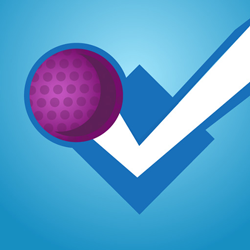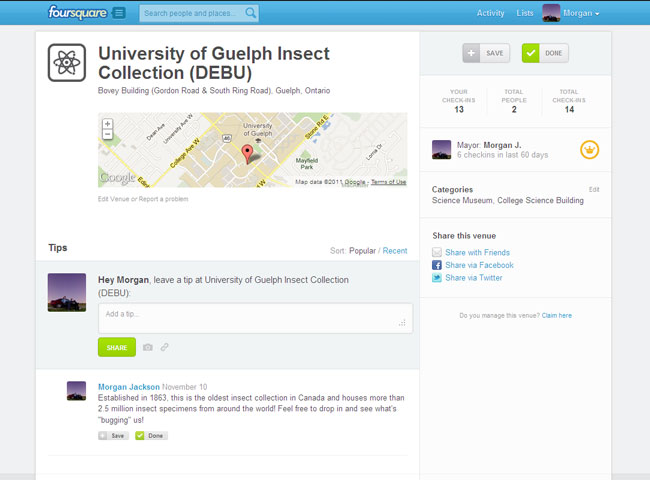Have you ever traveled to a new city and wondered where you can grab a burger, or perhaps a beer? How about wondering if there’s a good spot to bird watch or even collect a few flies in between meetings or family functions? One of the benefits of being a biologist is traveling to new locations, either to gather new data/specimens or to talk about your work on said data/specimens. Unless you have a local source of information, be it a friend, colleague or naturalist’s forum that can point you to a good park, the amount of time you spend looking for a site may equal (or be greater than) the amount of time you actually spend in the site. Wouldn’t it be great if there was a social network that could help you find natural areas faster, and let you see ahead of time what local naturalists were finding where?
 Good news; there IS a social network capable of all these things, it’s just that no one has begun to use it for that yet! Let me introduce you to foursquare, and explain how I think it can enhance interactions between naturalists and scientists.
Good news; there IS a social network capable of all these things, it’s just that no one has begun to use it for that yet! Let me introduce you to foursquare, and explain how I think it can enhance interactions between naturalists and scientists.
foursquare is a geography-based social network, allowing you to “Check in” to locations such as restaurants, events or shops and see where nearby friends have been recently. You can also leave “Tips” on things to do at a location or what’s good on the menu, and construct to-do lists of places you’d like to visit and things you’d like to do. While check-ins are only shared with your friends, the locations and tips are public and searchable, allowing you to plan trips or discover new venues.
While the network was designed for finding restaurants and bars in big cities, you can also create venues for all types of natural habitats; city greenspaces, provincial, state, or national parks (and even areas within those parks, like specific camp grounds or trails), your local arboretum, lake, or river, etc. Combine that with the Tips function and you have a GPS-enabled network which allows you to record recent nature sightings, notes on the type and quality of habitats, or anything else which may help others get the most out of their visit. Available through your web browser or on smartphones, it’s a very simple way to keep track of what you find and where!
Unfortunately I haven’t had much time in the past few weeks to explore local parks to provide you some examples, but here is the page I made for the University of Guelph Insect Collection (did I mention foursquare is a great way to increase the exposure of your local museum or natural history collection?):
As you can see, I’ve left a tip with some information about our collection and encouraging people to stop in and see what we do, but this is where you can leave sightings or other observations you’ve made at a location. These tips are searchable (try searching “1863 near Guelph, On” in foursquare for example), allowing people to discover potential natural history information (imagine a tip reading “Saw a bald eagle and 3 cedar waxwings today! #nature” or “Check the pond at the northwest corner for excellent dragonfly collecting #nature”). You could even go so far as to create a public list of natural areas in your region, making it even easier for others to discover new areas to explore.
So how can foursquare help naturalists and the public connect with researchers? Obviously the more people who join and record their naturalist outings in this way, the more data and locations visiting scientists may have to play with. eBird is a similar technology (without the mobile app) where birders around the world record the birds they saw, along with when and where, and which has created a near real-time database of bird diversity, ranges and migrations that is being used by ornithologists. I think by using foursquare in a similar way, researchers studying other groups can potentially do the same. Entomologically speaking, imagine the possibilities: citizen science programs tracking monarch butterfly populations, urban insect sightings (bed bugs in hotels, roaches in restaurants, etc), or taxonomists like myself finding new localities to collect in or records of uncommon species! More importantly though, is the ways in which a researcher can give back to the naturalist community. If you visit a location frequented by a local naturalist, why not meet up with them if they’re in the area, and of course share your own favourite locations and sightings for everyone to experience! I suspect that there are ways to harvest data or create secondary applications which work in concert with foursquare, but I don’t have the programming skills to explore those avenues (if you do and are interested, let me know).
Obviously for this idea to really work it will need to be adopted by naturalist communities across North America and beyond, but I think it has a lot of potential, and I’d encourage you to give it a try (and spread the word)! I’ll be continuing to record my visits and sightings, and I’ll be sure to provide future updates on how this idea progresses!
At a time when few people seem interested in the natural world around them, social media like foursquare create opportunities for us to share nature with everyone. If even one person who wouldn’t normally take the time to venture through a city park or visit an entomological museum does so because they learned of it through foursquare, I’d consider that a success!


The biggest hurdle to naturalists using foursquare in this fashion is having to register for yet another social media site, and making sure you aren’t the only one using it. It sort of reminds me of Project Noah, but for habitats instead of organisms.
I definitely agree it will take time and a gradual increase in the number of people using it, and it’s true functionality and benefits will take time to become apparent. The benefit of foursquare however, is that it’s not a closed system (like Facebook) so you don’t need a large network of “friends” who you share details with for the idea to work; the locations and observations are stored on a shared map and accessible to everyone. This means a single birder/naturalist can conceivably document all of the biological hot spots for a region easily and organically as they are out enjoying their hobby, making that information available for others to access and build upon. If the idea catches on and more people start including their own daily/weekly observations for locations, the scientific potential will be unleashed!